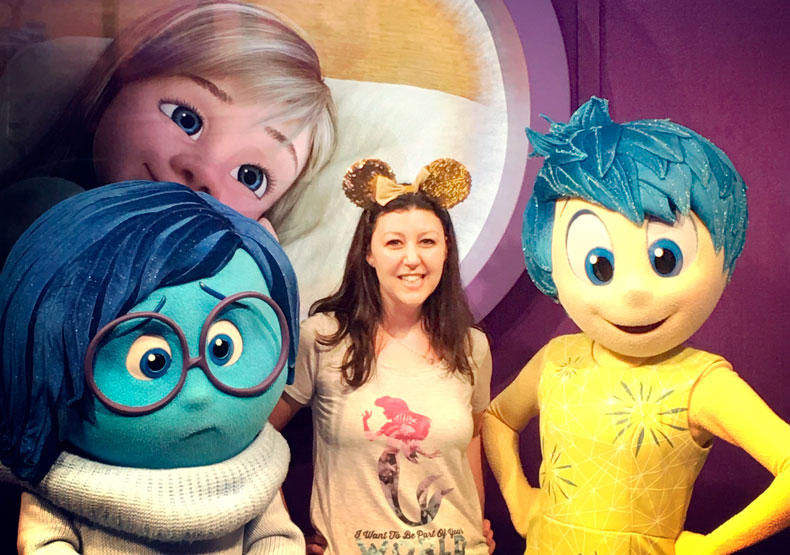Faculty Viewpoint: Katie Thomas Assesses the Relatability of Inside Out 2

Katie Thomas, M.S., LMHC, with Inside Out characters, Sadness and Joy
Inside Out 2 was recently added to the Disney+ lineup after a very successful run in theaters this summer, becoming the highest grossing animated film of all time. Based on the prevalence of Anna and Elsa merchandise that still tops holiday wish lists five years after the last film in the franchise was released, it’s surprising that the Inside Out sequel surged past Frozen II at the box office. Now that Inside Out 2 is available to a large audience through a top streaming service, social workers and counselors are sure to use the film’s messaging in therapy sessions with their young clients. After watching the movie, I wondered how many of my clients will see themselves in the central character, 13-year-old Riley who is navigating the often fraught social and emotional transition from girl to teen, from middle school to high school. While books, movies and television programs are powerful tools that can be used in therapy, not all content is a good fit for all clients.
Inside Out 2 begins with Joy, Riley’s primary emotion, managing the control center in Riley’s brain. I was struck by how in the movie’s opening moments, Joy calls Riley exceptional. I wondered how many of my clients, young or old, have an internal voice recognizing themselves as exceptional? Throughout the film Riley is focused on finding where and how Joy fits in her changing life. The characters representing Riley’s emotions posit a hypothesis: “I guess that’s what happens when you grow up, you feel less joy.” This heartbreaking idea might feel foreign to children who grew up with the positive messages and internal self-talk prompted by Joy.
The movie emphasizes the upheaval associated with puberty and how these often-unfamiliar feelings can shape a teen’s reactions to the changing world around them. But how lucky is Riley that Joy has been at the control center for 13 years before Anxiety, Embarrassment, Ennui, and Envy upend the crazy salad of emotions from Sadness, to Anger from Fear to Disgust.
According to SAMHSA’s National Child Traumatic Stress Initiative, two thirds of American children experience at least one traumatic event by age 16. These events include physical abuse, sexual abuse, neglect, community violence, witnessing domestic violence, and traumatic grief. I’m having a hard time believing that most young children wouldn’t experience Anxiety at the switchboard earlier.
The main fight between Riley’s emotions concerns Riley’s sense of self. The first message about herself that she internalized is, “Mom and Dad are proud of me.” As the film progresses, she remembers that she is “kind,” “strong,” “brave,” a good person,” and “a good friend.” The building blocks of Riley’s sense of self come from her parents who let her know that she is worthy of love and capable of loving, which allowed her to have the kind of self-talk Joy encourages throughout. This highlights that the relationship between a child and caregiver is central to a child’s mental health. Without that messaging from caregivers, children can struggle to develop a sense of self —rooted in positivity.
So many counselors love working with young children but don’t love working with their parents. It’s okay, me too! It’s been a long learning process for me to realize that if I wasn't doing parent work, my client wouldn’t make progress.
So many of my clients have had the sense of self informed by the same Anxiety that Riley develops in puberty. We hear Riley’s internal voice echo, “I’m not good enough” over and over during her panic attack. When Anxiety releases her grip on Riley, all the old messages from her childhood are there to ground her again. When our young clients don’t hear that they make their parents proud and that they are loved, they struggle to build positive core beliefs about themselves. Our work with children and adolescents can’t happen in a vacuum. Children exist in conjunction with caregivers and without their support, therapists will make only minimal progress.
I will be talking about Inside Out 2 with friends, colleagues, and clients for weeks to come. So many families and educators have responded positively because the film is giving them the language to discuss feelings with young kids. However, we need to acknowledge that it would be a very privileged child to have Riley’s experience. Anxiety says she keeps Riley safe from the things she can’t see. In her family, school, and community she didn’t need that protection until the summer before high school. For every child who is experiencing an active shooter drill at school or has parents struggling with a substance use disorder or unsure of where their next meal is coming from, Anxiety has already taken hold of the control center in their brain. Those experiences have created core beliefs often incompatible with sustaining friendships, learning, and prosocial behaviors. I hope Inside Out 2 gives us all a window into the minds of the youngest members of our community and the suffering Anxiety causes. The children and their caregivers need our compassion and our help.
Katie Thomas, M.S., LMHC is the Assistant Director of Field Education for the Counseling and Behavioral Health Department at William James College.
- Tags:
- In the Community
Topics/Tags
Follow William James College
Media Contact
- Katie O'Hare
- Senior Director of Marketing
- katie_ohare@williamjames.edu
- 617-564-9389
